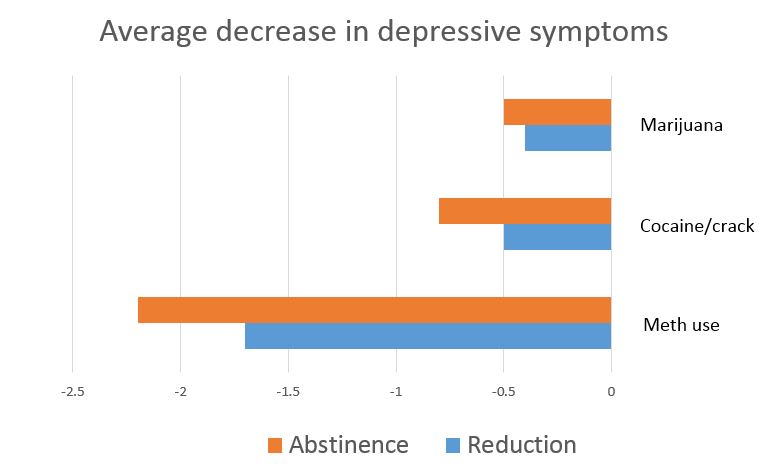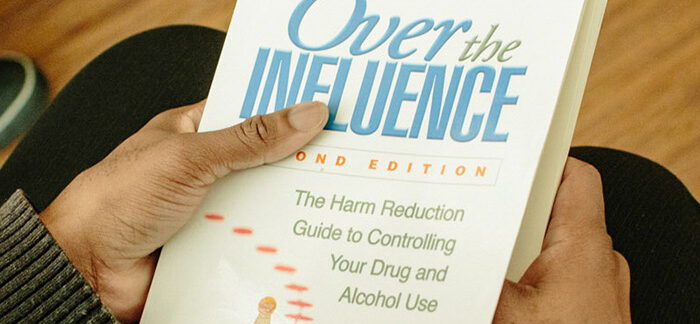Methamphetamine (meth) is a powerful stimulant that in the short-term can improve mood, energy levels and alertness—but when used long-term can lead to depression and other mental health concerns. Some people who use meth and want to make a change to their substance use opt for complete abstinence, through programs such as Crystal Meth Anonymous (CMA) with the belief that stopping substance use is the only way to “recover” from addiction. New research, published in JAIDS, is the latest in a long line of studies over many decades which shows that people struggling with substance use can experience significant improvements without abstinence.
I’ve been working in drug and alcohol counseling for about 8 years, and the take-home message from this study for me is that harm reduction works. A lot of people say that you have to quit meth to have any hope—but that’s just not true.
Many people are able to successfully use drugs, and many people who make changes to their substance use don’t do it with complete abstinence.
Details of the study
The study included 9,905 people living with HIV who reported the frequency that they used drugs including crack/cocaine, amphetamine-type substances (e.g., meth), illicit opioids and marijuana every six months. The researchers assessed depressive symptoms using a measurement tool called the Patient Health Questionnaire.
Most of the people in the study were men (84%) and 40% reported using a substance at the beginning of the study. A total of 1,016 reported meth use, 728 reported cocaine/crack use, 290 reported illicit opioid use and 3,277 reported marijuana use during the study. The researchers examined associations between changes in the use of individual drugs and depressive symptoms.
Over time, substance use reduction and abstinence were associated with improvements in depressive symptoms.
Changes in meth use were associated with the greatest improvements in depressive symptoms: Reducing meth also led to a significant decline in depressive symptoms (on average a decline of 1.7 points). Abstinence from meth reduced the depressive symptoms score on average 2.2 points (compared to people who continued to use).

For other drugs, the impact of abstinence and reduced use on depression was more subtle.
Stopping marijuana decreased the average depressive symptoms score by 0.5. Reducing marijuana was associated with a decrease of 0.4.
Stopping cocaine/crack decreased the depressive symptoms score by 0.8, but reducing use did not lead to a significant decrease in depressive scores.
Stopping or reducing use of opioids was not significantly associated with a reduction in depressive symptom scores.
“Reducing [amphetamine-type drugs] was more strongly associated with alleviation of depressive symptoms, perhaps suggesting that it has greater detrimental clinical impact, including on depression, than other drugs in this population,” the researchers speculated.
The intertwined effects of meth and depression
The results of this study closely align with what I see working with clients every day.
Depression and meth use are tightly intertwined. People who experience depression are more likely to seek out meth as a way to self-medicate, and people with no history of depression are more likely to experience depression after taking meth regularly.
The reasons are pharmacological.
Meth, a stimulant, can be an incredibly effective solution to depression in the short-term. People with mental health issues often use drugs as a way to self-medicate—seeking out the particular types of drugs that solve their mental health concerns. People who are anxious are more likely to use alcohol, benzodiazepines, marijuana and other depressants; people who are depressed are more likely to seek out stimulants like meth.
A lot of people that use stimulants, in particular, have pre-existing depression. And when they discover their stimulant of choice, they feel like, “Oh my god! I finally feel normal.” Meth floods your brain with dopamine, and also prevents the re-uptake of it. In the short-term, it can blow your depression out of the water.
The problem is that it’s next to impossible to regulate meth use (or any illicit substance) in a way that mirrors the precision of pharmacological therapy. People taking meth flood their system with high doses that spike dopamine levels and lead to dramatic crashes. Drug supplies are unreliable and can be filled with adulterants. People taking frequent, high doses develop tolerance. With time, the brain loses the ability to naturally produce endogenous dopamine, which makes it even harder to stop using. The self-medication benefits from meth use stop working over the long-term.
Long-term meth use also makes people more susceptible to depression, by changing the amount of endogenous dopamine produced by the brain.
These changes mean that it can be incredibly difficult to stop using meth cold turkey. Withdrawal and post-acute withdrawal, which people experience as depression, irritability, intense fatigue and more are the effects of the body and brain adapting to the loss of dopamine.
Many people opt to reduce their use of meth, as a way to reduce the negative impacts that meth can have while lessening the withdrawal symptoms that may come from stopping use outright. And this study shows that reducing your use—even if you don’t quit altogether—can lead to significant, measurable improvements.
Reducing use and other harm reduction strategies
Reducing substance use is one way to reduce the negative impact that drugs can have on your life, but it’s not the only way.
Substitution strategies involve understanding what one is getting from a drug, and then trying to find other less harmful drugs or non-drug related activities to fulfill those same needs. For example, many clients find that they can use cannabis to help reduce social or sexual inhibitions instead of using meth in social or sexual situations.
You can also change how you administer or use your drugs. Some clients find that injecting is more problematic for them than smoking, snorting or booty bumping. Some people believe that once you have injected, it is difficult to revert to a different mode of administration, but people make this change frequently and successfully.
Improving your safety when you use drugs is also a harm reduction priority. Even if you do not significantly change your quantity of use, you can do things like only invite people you know for party and play in your room. Or you can always let a close friend know where you are and ask them to check in with you after a certain amount of time to ensure that you are safe.
Another key strategy is timing your meth use strategically. You can make sure to eat, pay rent and bills, and make it to a medical appointment BEFORE starting to use meth. A person with a job may set boundaries such as only using on weekends, or cutting off their use at a certain time and trying to get at least a few hours of sleep. Some people also find it helpful to set alarms for times when they need to take medications, or strategically place water, lube or other safer supplies in places they will likely be when using.
The take-away message is that many people can use meth and still maintain a quality of life that is commensurate with their values.
—
Want to talk to someone about drugs or alcohol?
The Stonewall Project is here to help. Stonewall offers free harm reduction counseling to gay, bi and trans men who want to assess their substance use and are thinking about making changes. For more information and to seek services call 415-487-3100.
Source
Delaney, J.A. and colleagues. Brief Report: Reduced Use of Illicit Substances, Even Without Abstinence, Is Associated With Improved Depressive Symptoms Among People Living With HIV. JAIDS, November, 2018.










